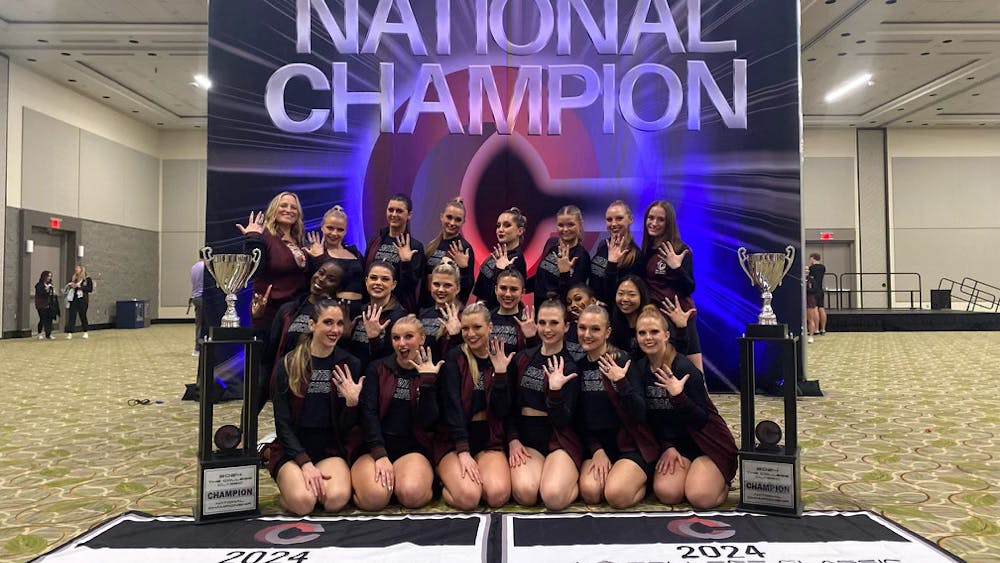Alumnus takes winding path to find himself through cartoons
Jay Fosgitt’s hands are always moving.
Put a pencil between the Saginaw native’s perpetually kinetic fingers, and a piece of paper below them. What emerges is a dream landscape of creepy and cuddly cartoons, ripped from the mind of a reluctant adult.
As an in-demand cartoonist with an all-ages appeal, Fosgitt makes a living drawing whimsical depictions of trolls, monsters and the occasional superhero. His credits range from “Sesame Street” comic titles to Steven Spielberg’s Dreamworks Magazine. On illustrated franchises like “My Little Pony,” he’s a fan favorite.
Fosgitt, 41, has only worked in the professional comics industry for less than a decade. Yet his talents propelled him this year to the Big Two as a rotating artist on Marvel Comics’ “Rocket Raccoon and Groot.”
Fosgitt’s art was featured in issue No. 5, which was out on stands May 4.
The issue contains art by Fosgitt and a story by Skottie Young, one of Fosgitt’s contemporary heroes. “Rocket Raccoon and Groot” chronicles the adventures of two popular Marvel characters made famous in the 2014 movie “Guardians of the Galaxy.”
Another recent Fosgitt-Marvel collaboration is the cover art for “Avengers Standoff: Attack on Pleasant Hill -- Alpha #1.” The issue is currently in circulation and sells as a hot commodity on eBay: a first-print edition goes for $25; a black-and-white sketch variant edition prices at $50.
To put this accomplishment into perspective, the going retail rate for a premium, single-issue comic book is just below $5.
Marvel is to comics what the NFL is to football, sharing its influence only with rival company, DC Comics. Making a leap to the major leagues is a dream come true for a childlike creator with a penchant for funnies.
“Ten years ago, my style wouldn’t have worked at Marvel,” Fosgitt said. “Guys like Skottie Young and Humberto Ramos – guys who have a cartoonish bent to their work – they really kicked the door open for people like me. They proved that this works in the superhero world. Stylistically, I think it’s a breath of fresh air.”
Fosgitt’s star is rising fast, but his acclaim goes well beyond the pages of comics. Bring up his name to fans and colleagues. In response, they’ll describe a man who is as loyal and friendly as he is talented.
People in the industry love Fosgitt, but only a handful know his inner conflicts. Like, how often his unyielding dedication leaves him sleepless and alone, or how he doesn’t feel comfortable if he isn’t drawing.
“I’m at a total loss when I don’t have an instrument in my hand,” Fosgitt said. “I panic. My art and humor are my suits of armor.”
Fosgitt is a walking identity crisis; an unbalanced scale made level only if he allows the creatures in his head to roam free. No matter what life throws at him, where’s he’s been or what he’s lost, Fosgitt just keeps his career moving forward.

Drawing outside the lines
It’s 6 a.m. and Fosgitt stirs restlessly in bed.
Visions of Muppets and monsters rattle his brain. Wiping drowse and crust from his hazel brown eyes, he slinks across the room to his production desk, and punches in.
His entire Plymouth, Michigan apartment is a studio, littered with utensils and lightboxes for tracing; hordes of puppets always sit nearby his desk for reference. When inspiration stops, he changes venues – the dining room – something closer to his movie collection, which he keeps rolling in the background.
Fosgitt draws sometimes for 15 hours straight, taking breaks only to walk around scenic downtown Plymouth, or to eat, or maybe not at all. He wouldn’t have it any other way.
“I view my line of work as a total gift,” he said. “I never felt the same sense of fulfillment doing anything else.”
In his early years, Fosgitt knew he would be an artist. Most of all, he loved puppeteering, and wanted to work with his idol, Jim Henson. Those movies in the background? They’re mostly Muppet Show reruns or his favorite Henson-inspired features.
As a toddler, Fosgitt would sit in front of the family television and daydream, and draw. With a pen in hand, he turned paper, and his bedsheets, into a canvas of odd shapes and rigid lines.
“I just took to it, nonstop,” Fosgitt said.
He’d imagine Henson was his biological father, building with him incredible worlds of technicolor fleece. Fosgitt would later write fan letters to his mentor, hoping Henson would write back.
Doug Fosgitt, Jay’s adoptive father, indulged his son, but his patience wore thin as Fosgitt aged. A "prototypical dad" more interested in cars than puppets, Doug begged his son to quit cartooning.
Fosgitt ignored him. His hands kept moving, drawing posters for high school functions, or doing caricature work for corporate parties. He started conjuring up his own characters – reflections of himself in cartoon form.
First, it was Dead Duck, the titular star of his breakthrough graphic novel. Later, he would design “Bodie Troll,” another creation that would propel his career.
He graduated from Swan Valley High School in 1993, and immediately enrolled in art programs at Delta College. He graduated from Central Michigan University in 2004. Fosgitt produced strips for both college newspapers, and at Central Michigan Life, his work gained a healthy following.
At CMU, he met Laura Tanner, his now ex-wife and closest confidant. The two remain good friends. Fosgitt would temper his obsession to split time with Tanner – even as his first love crept in uncontrollably.
“He is a walking, talking, living breathing cartoonist,” she remembered. “Day and night, he was always drawing.”

Cartoon Therapy
Fosgitt’s hands kept moving.
Upon graduation, he started working menial jobs to hold down a steady paycheck. He drew sketches for Topps Cards and took other freelance gigs as they came along.
In his off time, Fosgitt revisited his Dead Duck strips and made them better. In 2009, he released the collection as a graphic novel through Ape Entertainment. The novel was a slow hit, but it has since turned into a cult classic. Original copies sell for hundreds of dollars on eBay -- $700, to be exact, at its highest price.
Dead Duck, Fosgitt said, tells the story of a waterfowl adopted by the Grim Reaper. He helps Death collect the dead – a task he absolutely abhors. With a voluptuous sidekick and dark themes, the book is an adult romp with a childish bent – something Fosgitt’s come to specialize.
Bodie Troll, in comparison, is much tamer. It’s fan base is made of mostly children and young adults. Bodie, Fosgitt explained, wants to be the scariest troll in his cartoon universe, but isn’t taken seriously because he’s just so darn cute.
The success of both books proves to Fosgitt that jovial authenticity trumps grim ribaldry any day of the week. But as a mirror to his experiences, Bodie and Dead Duck help keep Fosgitt’s inner demons at bay, when his lack of confidence fails him and makes him feel alone.
It makes sense, then, that Fosgitt spent most of his childhood wishing his was anyone other than himself.
Fosgitt was born in 1974 to an underage mother who immediately put him up for adoption. It would be decades before he even knew her name, and to this day, they don’t speak. Doug and his now ex-wife, Sharon Schindette, adopted Jay a month after his birth.
Since they day he came home, Fosgitt was shy and terminally reserved.
“I was very isolated, but in a positive way,” he recalls. “I really didn’t have meaningful relationships with people until high school, and this was all back before it was kind of cool to be considered a loner. Comics, movies and entertainment, these are the things that kept me sane.”
Dead Duck is the manifestation of his awkward upbringing.
“Dead Duck is of questionable parentage, and he had to create his own identity from the ground up,” Fosgitt said. “I had that same situation.”
Bodie represents Fosgitt in the same way, however inverted.
“I’m sort of the opposite of Bodie, in that I’m a big gruff, rugged guy who’s pretty gentle and just wants to be seen that way,” he added.
His sensitivity is both a blessing and a curse. On one hand, Fosigtt turns sketches into unbridled happiness, as described by Kat Inokai, his good friend, marketing agent and fellow artist.
“He has these fantastic powers of observation, and that really makes him a great friend,” Inokai said. “I have an autoimmune disorder that leaves me bummed out sometimes. He’ll pick up on that and draw me a Bodie, or draw my children, and it will make me smile.
“He’s knows how to commemorate special moments that end up making you really happy.”
On the contrary, Fosgitt is his own worst enemy, the first to fold if a critic rips him to shreds.
“Jay’s a perfectionist who expresses his feelings with art,” Inokai said. “When some fan or critic is being an asshole to him for no reason, he takes that very personally. One of his biggest obstacles is the differentiation in his head between comic art and cartoons.”
That’s especially true on beloved franchise work. Such is the case with My Little Pony, a fandom rife with rabid haters.
“Criticism hits me like a hammer sometimes,” Fosgitt said. “If someone likes my work on that franchise, they love it. If they don’t, you’ll hear about it in the most negative way possible.”
Fosgitt’s supporters help cage the loathing, as do his tight-knit relationships with other artists.
“Creatives can have a hard time finding the fuel for nonstop confidence,” Inokai said. “It’s hard for Jay to give himself credit for the great work he’s done. I remind Jay that Marvel, of all people, wants to work with him. If you doubt your work, then trust the publisher and what they see in you.”

Keeping the faith
Still, his own feelings of loss still get the better of him.
Tanner and Fosgitt divorced in 2013. Fosgitt doesn’t believe his work caused the rift, but that’s not the way Tanner sees it.
“He was always so married to his work,” she said. “I believe so much in his talent, but after 10 years, something needed to change in his work. I never blamed him, for any of it, but I really felt like I was preventing him from going as far as he could.”
The subsequent split nearly broke him.
“It really rocked my world,” he said. “I didn’t know if it was going to hurt the future of my work, especially Bodie Troll.”
Then something miraculous happened. Fosgitt received an email from Karen Falk, the exclusive archivist for the Jim Henson Company. Back when Fosgitt wrote letters to his hero, he included drawings of characters and long exaltations of Henson’s work.
“When I was 11 years old, Jim wrote me back personally,” Fosgitt said. “He said thank you. He said that he liked my work, and to keep in touch when I graduated. It was the greatest moment in my life at that point, to have validation from my hero.”
Henson died in 1990. Fosgitt was devastated.
“It stopped me dead in my tracks,” he said. “There was no working for Henson’s without Jim.”
Fast forward back to the email. Falk explained that she was reorganizing Henson’s personal files. Within those files was Fosgitt’s letter. He kept it after all this time.
“She said here’s a scan of both letters, and if you’re in New York, be sure to get in touch with us,” Fosgitt said. “I can’t even begin to tell you how much that letter saved my life. It was like Jim was reaching out from wherever he was, saying ‘I’m here to help you. I’m here to guide you.’”
Fosgitt eventually took Falk up on her offer, and toured the Henson studios. His life and career had come full circle.
Henson helped him even in death. In separation, Tanner helped him become a better artist. And in his old age, Doug Fosgitt finally told Jay he was proud of him. That he was happy he ignored him all those years ago.
With renewed vigor, and a little help from his friends, Fosgitt muscles on. The pages of Marvel Comics will draw out his legacy, and his kindness will continue to influence colleagues and fans alike.
“It’s taken a long time to get the recognition I have,” he said. “I want people to see my art as an extension of myself, and to make them happy. I want them to see Jim’s influence as well. If that’s the legacy I leave behind, I’m content.”
Fosgitt may work until his bones are weary. His fingers cramped and swollen, but his hands just keep moving.







